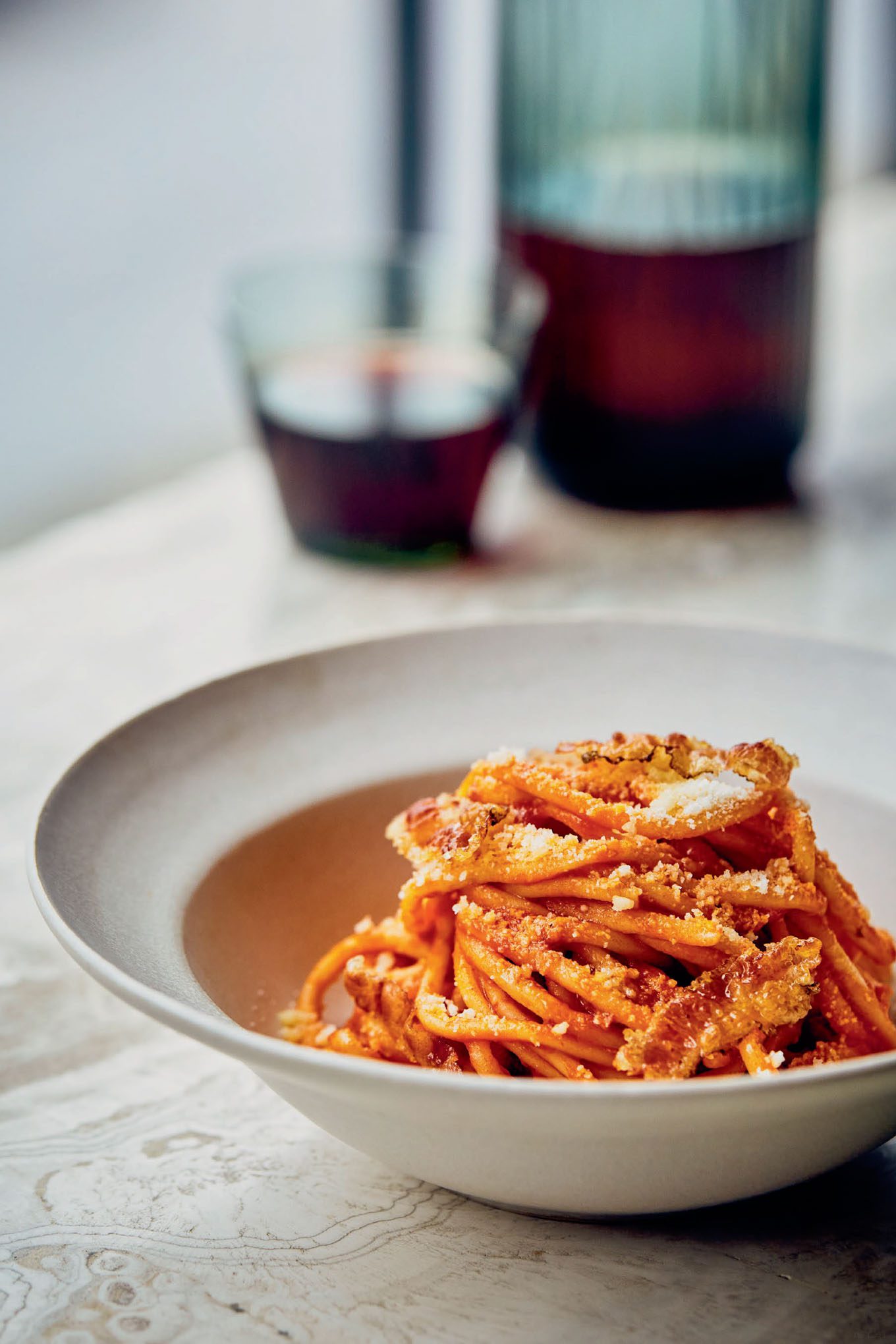
Words by Missy Robbins and Talia Baiocchi. Photo by Kelly Puleio.
How could a sauce with just three ingredients (or is it four? or five?) inspire so much debate? Despite it being right there in the name, the origin of the dish is also disputed. The Romans often claim the dish as theirs, and not Amatrice’s, a town at the crossroads of Lazio, Abruzzo, and Umbria now more famous for its devastating earthquake in 2016 than for its namesake pasta. Some even go so far as to print the rebuke on menus, referring to the dish as la matriciana or all’amatriciana instead of all’amatriciana.
The most fervent debate, however, comes down to the use, or not, of onions and garlic. In Amatrice, the dish is unadorned: tomatoes, pecorino cheese, guanciale . . . maybe chile flakes. That’s it. But like most dishes that have become part of the Roman canon (carbonara, cacio e pepe) and have thus made their way around the globe, this one invites attempts at improvement. In the past, I was guilty of overcomplicating the dish myself.
Neither onions nor garlic make their way into my interpretation of the dish, despite the fact that the amatriciana I fell in love with leaned so heavily on the former. When I was cooking in Chicago and traveled to New York, my first stop was almost always for a bowl of Mark Ladner’s amatriciana. His version is feral and rustic, with pearlescent sheets of red onion the size of walnuts and thick, crispy pieces of guanciale. It’s a dish that has a tribe of devotees.
My version is more traditional, and not out of reverence. To me, the genius of amatriciana lies in the combination of tomato, pecorino, and guanciale (plus chile flakes, always). Note that the dish can take additional heat, so feel free to scale up your use of chile if you so desire.
Pasta: The Spring and Craft of Italy’s Greatest Food is available now.
Bucatini all’Amatriciana: Pasta with Tomato, Guanciale, and Pecorino
Ingredients
- 28 g (2 Tbsp) olive oil, thinly sliced
- 160 g (5½ oz) guanciale
- 456 g (2 cups) tomato passata
- ½ tsp dried red chile flakes
- 624 g ( 1 lb 6 oz) extruded bucatini
- 30 g (⅓ cup) pecorino romano, plus 22g / ¼ cup for garnish
Instructions
- To make the sauce, place a large sauté pan or Dutch oven over medium-low heat. Line a plate with paper towels.
- Add the olive oil and guanciale to the sauté pan and cook until the fat has rendered and the pieces are just beginning to turn golden but have not browned (remember that they will crisp up when you remove them from the pan), 5 to 8 minutes.
- Using a slotted spoon, remove one-quarter of the guanciale and place on the paper towels to drain. Reserve these pieces for garnish.
- Turn down the heat to low, add the tomato passata and chile flakes, and cook until the rawness of the tomatoes is cooked out and the flavors have melded, 8 to 10 minutes. You are not looking to reduce the sauce.
- To finish, bring a large pot of water to a boil over high heat. Generously salt the water.
- Add the bucatini to the water and cook for 5 to 8 minutes, until al dente.
- Using tongs or a pasta basket, remove the pasta from the pot and transfer to the sauté pan. Add a splash of pasta cooking water and toss for 1 to 2 minutes to marry the pasta and the sauce. Remove from the heat and add 30g / ⅓ cup of the pecorino while tossing or stirring
- to combine. If the sauce feels tight, add a splash more pasta cooking water to loosen and continue tossing. When the pasta is properly married, it will cling to the sauce and have a glossy sheen.
- Divide the pasta into bowls and garnish with the remaining pecorino and reserved guanciale.
Reprinted with permission from Pasta: The Spirit and Craft of Italy’s Greatest Food by Missy Robbins and Talia Baiocchi, copyright © 2021. Published by Ten Speed Press, an imprint of Penguin Random House.